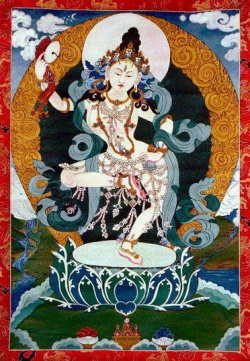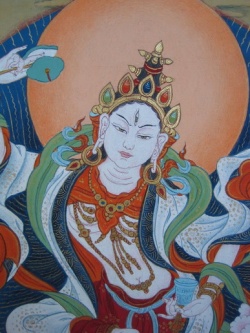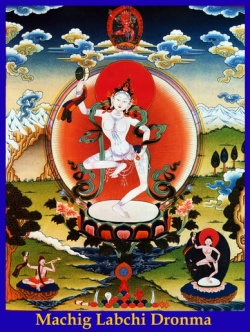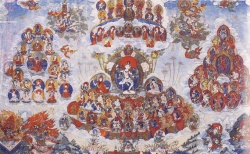Dakini No Daka
A dakini is a tantric figure representing a female embodiment of enlightened energy. The Tibetan khandroma, translates as ‘she who traverses the sky’ or ‘she who moves in space’ (or ‘sky walker’ or ‘sky dancer’).
The dakini is so central to a Tibetan Buddhist practitioner attaining full enlightenment as a Buddha that she appears in a Vajrayana formulation of the Three Jewels Buddhist refuge formula, known as the Three Roots. Most commonly she appears as the dharma protector, alongside a guru and yidam, but Judith Simmer-Brown points out that:
The dakini, in her various guises, serves as each of the Three Roots. She may be a human guru, a vajra master who transmits the Vajrayana teachings to her disciples and joins them in samaya commitments. The wisdom dakini may be a yidam, a meditational deity; female deity yogas such as Vajrayogini are common in Tibetan Buddhism. Or she may be a protector; the wisdom dakinis have special power and responsibility to protect the integrity of oral transmissions.
As a key tantric figure the dakini also appears in other forms of tantric Buddhism such as the Japanese Shingon school from where she disseminated into Japanese culture, evolving into Dakini-ten and becoming linked to the kitsune iconography. The origins of the dakini figure are uncertain but she continues to this day as a part of Indian folklore, generally in wrathful forms, and remains a part of Hindu tantra.
In Tibetan Buddhism
Although dakini figures appear in Hinduism and in the Bön tradition, dakinis occur most notably in Vajrayana Buddhism and play a particular role in Tibetan Buddhism. There the dakini, generally of volatile or wrathful temperament, acts somewhat as spiritual muse (or inspirational thoughtforms) for spiritual practice. Dakinis are energetic beings in female form, evocative of the movement of energy in space. In this context, the sky or space indicates shunyata, the insubstantiality of all phenomena, which is, at the same time, the pure potentiality for all possible manifestations.
Classes of dakini
Judith Simmer-Brownfour main classes of dakini, based on teachings she received from Tibetan lamas, identifies . These follow the Twilight Language tradition of esotericism in referring to secret, inner, outer and outer-outer classes of dakinis.
The secret class of dakini is Prajnaparamita (Tibetan yum chenmo) or voidness, the empty nature of reality according to Mahayana doctrine.
The inner class of dakini is the dakini of the mandala, a meditational deity (Tibetan:yidam) and fully enlightened Buddha who helps the practitioner recognise their own Buddhahood.
The outer dakini is the physical form of the dakini, attained through Completion Stage Tantra practices such as the Six Yogas of Naropa that work with the subtle winds of the subtle body so that the practitioner’s body is compatible with an enlightened mind.
The outer-outer dakini is a dakini in human form. She is a yogini, or Tantric practitioner in her own right but may also be a kamamudra, or consort, of a yogi or mahasiddha.
Dakinis can also be classified according to the Trikaya, or three bodies of a Buddha.
The Dharmakaya dakini, which is Samantabhadri, represents the Dharmadhatu where all phenomena appear.
The Sambhogakaya dakinis are the yidams used as meditational deities for tantric practice.
The Nirmanakaya dakinis are human women born with special potentialities; these are realized yogini, the consorts of the gurus, or even all women in general as they may be classified into the Five Buddha Families.
In Anuttarayoga Tantra
Being associated with energy in all its functions, dakinis are linked with the revelation of the Anuttarayoga Tantras, which represent the path of transformation, whereby the energy of negative emotions or kleshas, called poisons, is transformed into the luminous energy of enlightened awareness yielding the most profound experience of clear light. Thubten Yeshe explains:
When the completion stage practices have been mastered and we have gained control over our subtle energy winds and so forth, there will come a time when the dakas and dakinis will come… physically embracing such a consort is necessary to bring all the pervading energy winds into the central channel, a prerequisite for opening the heart center and experiencing the profoundest level of clear light.
In Hinduism
In Hinduism the term dakini often has negative associations although in Hindu tantrism dakinis are the guardians of the deeper mysteries of the self, through whom the secrets of inner transformation are revealed. There is a distinction between terms such as shakti, yogini, shakini and dakini, although in general conversation it is often blurred and the terms used interchangeably. For example Rajaram Narayam Saletore records that in Bengal a shakini is a type of witch that may be called a dakini in other parts of the country.
According to one legend Dakini and Shakini were the wives of Tripurasura. After Tripurasura was slain by Shiva, they received the boon from Shiva that they could live in the forest without any threat and people would have to chant their names before they could visit the shrine of Bhimashankara. Hence the forest around there became known as Dakini Forest.
In Hindu Tantra, practices such as Tantric sex may involve a “helper” dakini – a human female trained in tantric yoga – or even an “actual” dakini.
In Hinduism, persons seeking siddhi, or powers, such as yogis often have to face challenges from dakini, shakini and other wrathful or semi-wrathful female figures. They have to be defeated or overcome in order to gain siddhi and thus become a Mahasiddha or a true yogi, with control over the elements of nature. There are many mantra and strota in Hindu scripture that are believed to defeat or grant protection from dakini, shakini and others.
The chief deity who has control over dakinis and so forth is Hanuman. The Vichitra Veer Hanuman Stroram, sung in praise of Vichitra Veer Hanuman, a ferocious form of Hanuman, details the negative elements over whom Hanuman has control, including dakini. There are many other Hanuman mantras to win over a dakini,among which famous ones are Panchamukhi Hanuman Kawacham and Saptamukhi Hanuman Kawacha. Hindus also recite Sri Sudarshana Kawacha, a Sanskrit shloka or kawacha sung in praise of Vishnu and named after his weapon Sudarshana Chakra to get protection from dakinis or to dispel dakinis and others.
Dakini, Shakini, Kakini, Kamini are per Hindu tantra also the shaktis or powers who control the different Chakras. Thus dakinis are the guardians of the deeper mysteries of the self, and it is through them that the secrets of inner transformation are opened. Once a person is able to awaken Kundalini and move it from its base, Muladhara to top Sahastradhar, he becomes a Yogi.
In Japanese Buddhism
Although the dakini imagery appears to have come to Japan via Kukai’s introduction of tantric Buddhism in the Shingon school in the early 9th century, her form appears more like the dakinis of Hindu iconography than those found in the Tantra of Tibetan Buddhism, the other main surviving school of tantric Buddhism.
The dakini image was mixed together with images of foxes and half-naked women, acquiring the names Dakini-ten (Dakini-deity, 荼枳尼天), Shinkoō-bosatsu (Star Fox Queen-Bodhisattva, 辰狐王菩薩), and Kiko-tennō (Noble Fox-Heavenly Queen, 貴狐天王).
The modern folk belief, often printed in Japanese books about religion, is that the fox image was a substitute for the Indian jackal, but the jackal is not associated with Dakini anywhere. As another example of the connection between Dakini-ten and the government of Japan, in the Genpei Jōsuiki it is claimed that Taira no Kiyomori met a kitsune on the road and that his subsequent performance of Dakini-ten rites caused him to rise from an unimportant clan leader to the ruler of the entire nation.
In early modern times the Dakini rite devolved into various spells called Dakini-ten, Izuna, and Akiba. People who felt wronged in their village could go to a corrupt yamabushi who practiced black magic, and get him to trap a kitsune and cause it to possess a third party. Reports of possession became especially common in the Edo and Meiji periods. For details, see kitsunetsuki.
Associations with other cultures
In Iranian Themes in Tibetan Tantric Culture: The Ḍākinī, David Templeman points out the links between dakinis as found in Tibetan Buddhism and Urgyen which is in what is now Northern Pakistan. He suggests that this links the wrathful dakinis to another form of wrathful female, the Persian peri.
Daka
There is some disagreement amongst Western scholars as to the meaning of the term daka. Some see it as the same as a dakini but in its male embodiment, and thus to be the partner of a female practitioner or yogini, or to identify a daka as the consort of a dakini. However in consort yoga, the consort of a dakini is a yogi.
For example, Padma Sambhava was known as a yogi and Yeshe Tsogyal as a dakini. Miranda Shaw in an interview in 1995: “In Sanskrit there is only one word, Dakini. There are only female Dakinis… there is no male Dakini. It is an impossibility and a contradiction in terms.” Whereas Jan Willis in the chapter Ḑākinī; Some Comments on Its Nature and Meaning points out that “”she” is not “female”. Though the ḍākinī assuredly most often appears in female form… this is but one of the myriad of ways Absolute Insight chooses to make manifest its facticity”.
However, Tibetan Lamas trained in the Gelug school, such as Sermey Khensur Lobsang Tharchin and Kelsang Gyatso, and those of the Karma Kagyu school such as Khenpo Karthar Rinpoche, write freely of “dakas and dakinis”. Thubten Yeshe clarifies their meaning: “what are dakas and dakinis? Simply speaking they are males and females who possess advanced experiences of tantric transformation and control and are therefore able to increase the blissful wisdom of a highly qualified practioner”.




